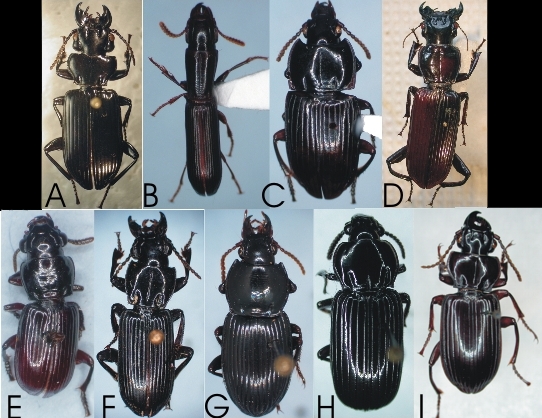Morionini
Brullé 1835
 The genera:
The genera:
A- Platynodes
B- Hyperectenus
C- Buderes
D- Hyperion
E- Morionidius
F- Morion
G- Moriosomus
H- Stereostoma
I- Megamorio
Related files:
Recognition of member taxa- The combination of moniliform
antennomeres,
prominent eyes (except in Hyperectenus Alluaud), elytral
plica not
externally visible, expanded apex of the protibia with a
apico-laterally produced spine (except in Morionidius Chaudoir) and
projecting
dentiform process above the insertion point of the antenna is
characteristic of members of this tribe.
All species in the tribe are deep black to piceus brown,
rather shiny and typically large sized, most about 15-30mm (range
8-80mm). Most species are Morion-like
in general form, elongate,
parallel-sided and somewhat depressed and subpedunculate. However, many
of the genera, which contain about a third of the species, are much
more compact and convex in form. All have deeply impressed frontal
impressions on the head and deep, linear pronotal basal
impressions.
Allen
(1968) presented five features he considered to characterize the
tribe; moniliform antennae, elytral plica internal, 4-12 setae on
lateral margin of the pronotum, stria 8 with alternating setigerous
punctures and the rod-like process of the endophallus. Many taxa do
have these feautures, however, aside from the
moniliform antennae, none of these characters is found to be definitive
for the
tribe as a whole. Most of these are known only in the more derived
Morion-like genera and
exception are common, e.g., Hyperion Laporte de Castelnau
lacks
pronotal setae, Buderes Murray and Hyperectenus
lack the additional setigerous
punctures of stria 8 and Stereostoma does not have the
process of the
endophallus.
Distribution/Diversity-
Presently there are 87
named species in the tribe (see lists on genus' pages), the majority
(69) in Morion Latreille and Stereostoma Murray. Most
species are found in tropical or subtropical regions with a few taxa
reaching low latitude temperate areas.
Taxonomy/Systematics-
Monophyly for the tribe is supported by a single
synapomorphy, moniliform antennomeres a characteristic found in several
other
groups of Carabidae, and in Hyperion the antennae are
submoniliform. Other characters of the eyes and head, unders specific
optimization hypotheses may support the monophyly of Morionini. Overall
there is little
support for a monophyletic Morionini including Stereostoma and
Morionidius.
 The genera:
The genera: The genera:
The genera: